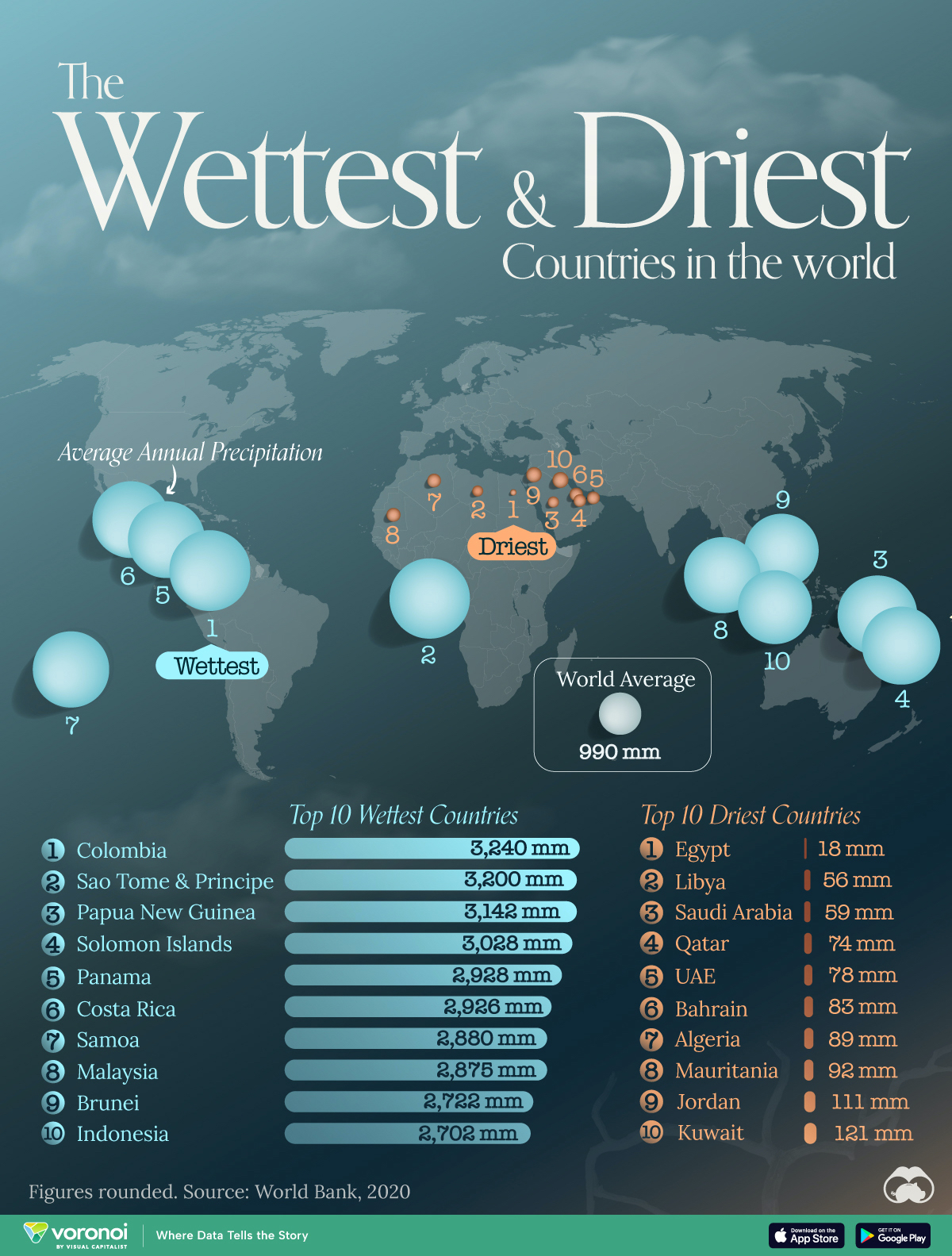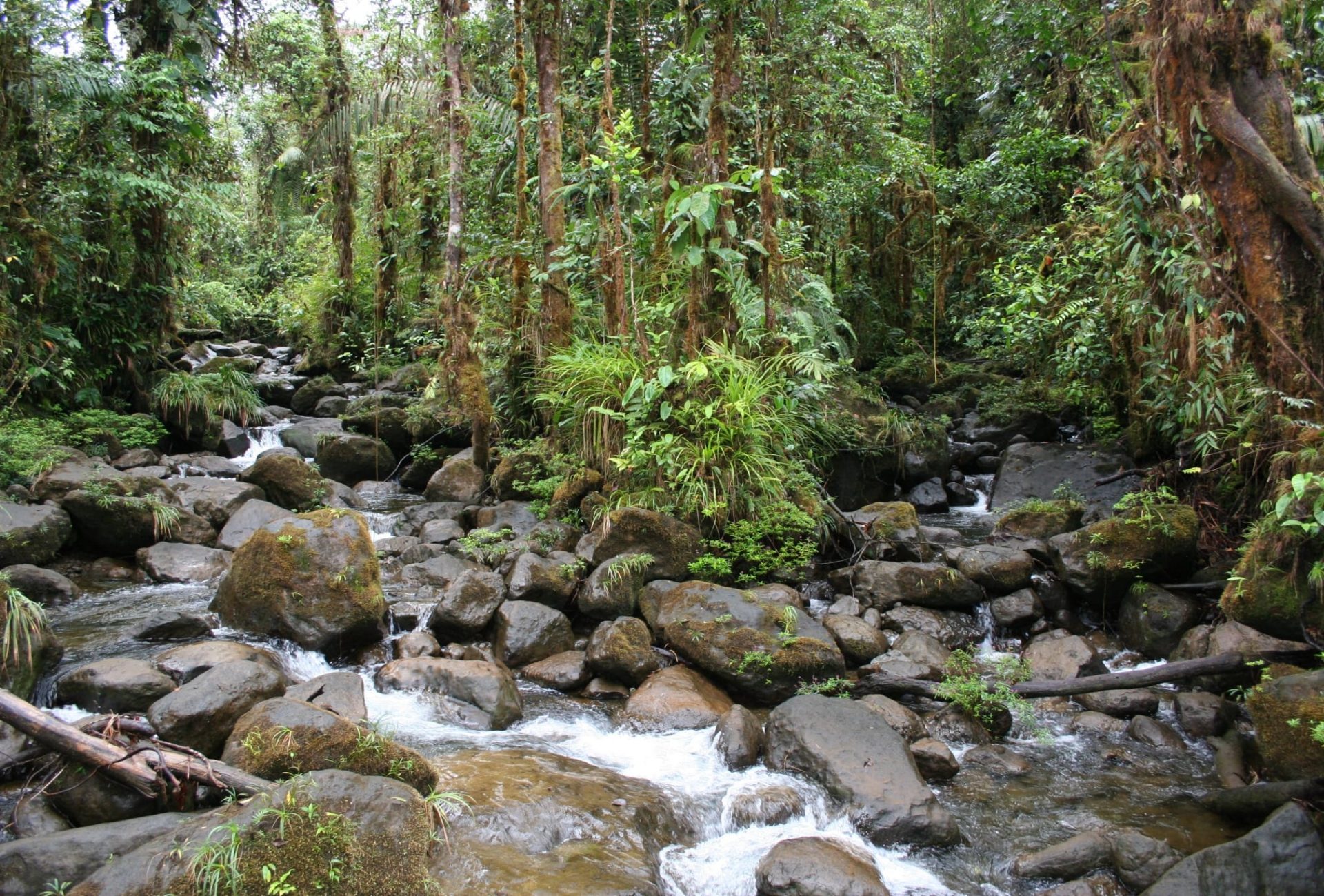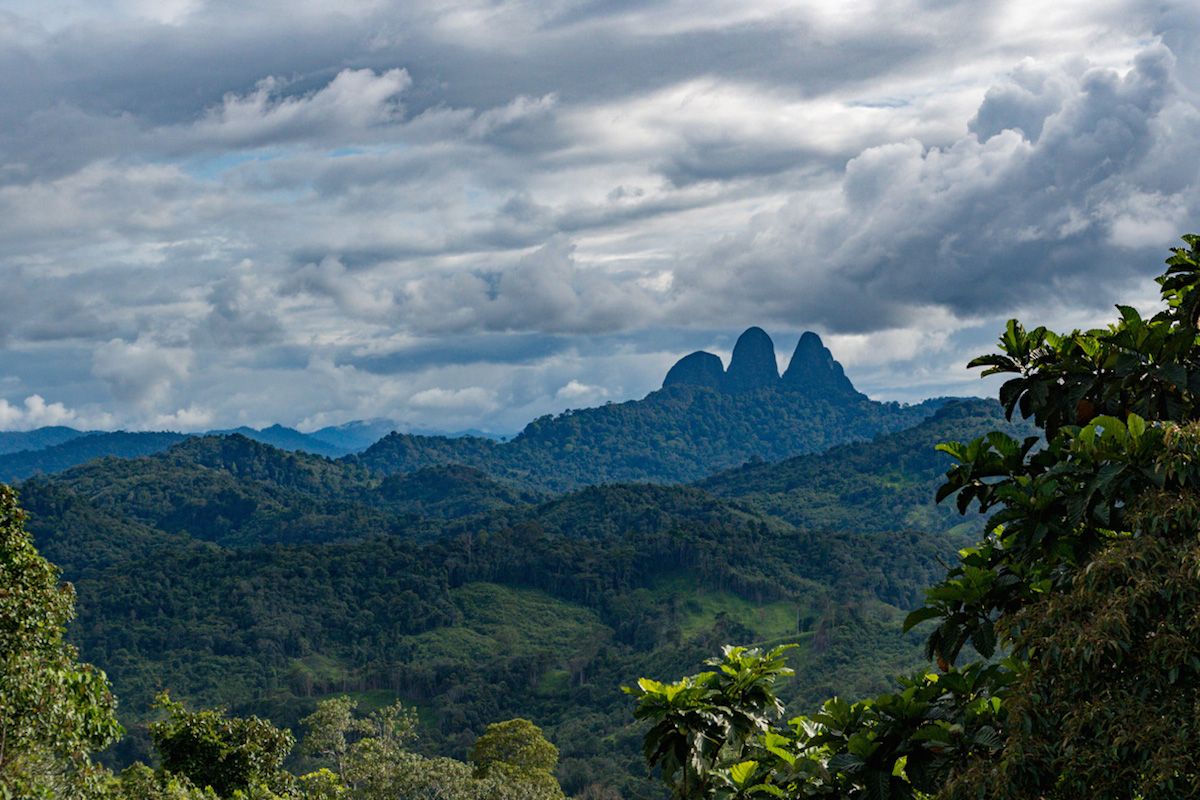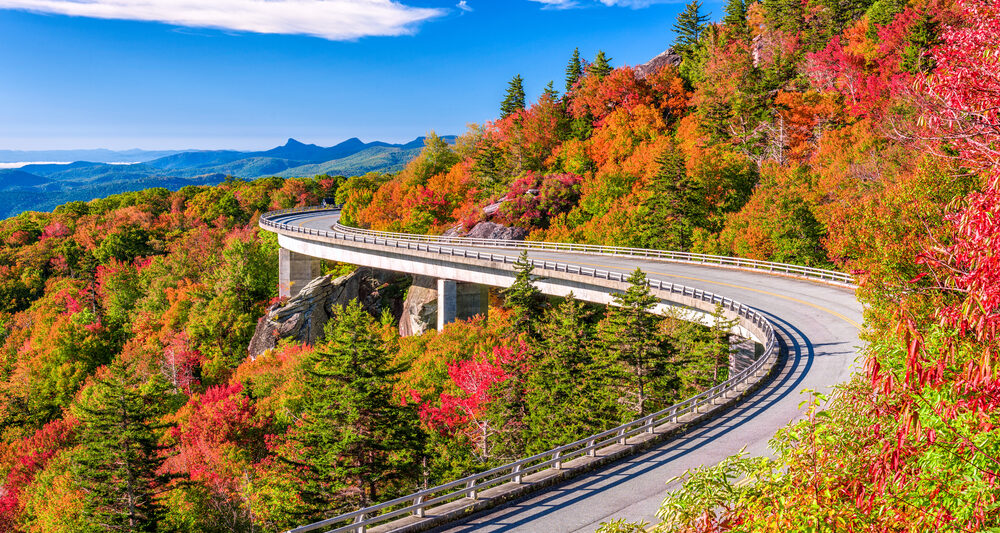Results from an exercise in charting the world’s wettest and driest countries probably won’t surprise anyone.
From the lush rainforests of South America and Southeast Asia to the arid deserts of North Africa and the Middle East, the world’s wettest and driest countries present a fascinating study in climatic extremes. Visual Capitalist recently took the statistics and created a chart showing the contrasts. Let’s explore the nations that top these contrasting lists, using the latest data (2020) from the World Bank.
In considering the figures below, note that the overall world average annual precipitation is 990 mm, or just over 39 inches.

TOP 10 WETTEST COUNTRIES
1. Colombia – Leading the pack with an impressive 3,240 millimeters (128 inches) of average annual precipitation, Colombia is a haven for rain.
More locally, the Tutunendo district, renowned as one of the wettest places on Earth, records nearly 12,000 mm (463 inches) of rain in some years. Colombia’s abundant rainfall supports its diverse ecosystems, from Amazonian rainforests to Andean cloud forests.

2. Sao Tome & Principe – This tiny island nation off the coast of Africa receives about 3,200 mm of rain annually. Its equatorial location and oceanic surroundings contribute to its heavy rainfall, nurturing its rich biodiversity.
3. Papua New Guinea – With an average of 3,142 mm of rain annually, Papua New Guinea’s tropical climate ensures lush rainforests and vibrant marine life thrive.
4. Solomon Islands – These islands receive 3,028 mm of rainfall each year, fostering dense tropical forests and a variety of unique flora and fauna.
5. Panama – Averaging 2,928 mm of rain, Panama’s climate is ideal for its rainforests and the crucial Panama Canal, which relies on ample rainfall to function.
6. Costa Rica – Known for its biodiversity, Costa Rica receives 2,926 mm of rain annually, feeding its rainforests, cloud forests, and extensive river systems.

7. Samoa – This Pacific island nation enjoys 2,880 mm of rainfall each year, sustaining its lush landscapes and vibrant ecosystems.
8. Malaysia – Averaging 2,875 mm of rain annually, Malaysia’s tropical climate supports its extensive rainforests and diverse wildlife.
The wettest local area in Malaysia, however, is notably higher. Based on average annual precipitation, Kuching, near the northern coast on the island of Borneo, stands as Malaysia’s wettest place. Kuching experiences an impressive average annual rainfall of around 4,000 mm (157.5 inches). This high level of precipitation is largely due to its location within the equatorial rainforest region, which contributes to its consistently significant rainfall throughout the year.

9. Brunei – This small Southeast Asian country receives 2,722 mm of rain each year, fostering its rich natural environment.
10. Indonesia – Rounding out the top ten, Indonesia averages 2,702 mm of rainfall annually, crucial for its vast archipelago of rainforests and agricultural activities.
Notably, all these countries lie near the equator and oceans, where warm, humid air rises and leads to copious rainfall.
TOP 10 DRIEST COUNTRIES
On the flip side, the driest countries are predominantly found in the arid regions of North Africa and the Middle East.
1. Egypt – Egypt tops the list with a meagre 18 mm (0.7 inches) of average annual rainfall. This stark contrast to Colombia highlights the extreme variability in global precipitation patterns.

2. Libya – Receiving just 56 mm of rain annually, Libya’s vast deserts dominate its landscape.
3. Saudi Arabia – With 59 mm of average annual rainfall, Saudi Arabia’s arid climate is characterized by its expansive deserts.
4. Qatar – This small Gulf nation receives 74 mm of rain each year, contributing to its dry, desert environment.
5. UAE – The United Arab Emirates averages 78 mm of rainfall annually, with most of its precipitation occurring in brief, sporadic showers.
6. Bahrain – With 83 mm of rain each year, Bahrain’s arid climate is typical of the region.
7. Algeria – Averaging 89 mm of rainfall, Algeria’s climate is dominated by the Sahara Desert.
8. Mauritania – This West African nation receives 92 mm of rain annually, making it one of the driest places on the continent.

9. Jordan – With 111 mm of annual precipitation, Jordan’s dry climate is punctuated by occasional rain.
10. Kuwait – Rounding out the list, Kuwait averages 121 mm of rainfall each year, reflecting its arid desert environment.
These countries’ minimal rainfall is a stark contrast to the lush, rain-soaked landscapes of the wettest nations, highlighting the diverse climatic conditions that shape our world.
APPRECIATING EARTH’S CLIMATIC DIVERSITY
Understanding the world’s wettest and driest countries offers valuable insights into the planet’s diverse climatic patterns. From nurturing biodiversity in rain-drenched regions to adapting to arid environments, these extremes underscore the resilience and adaptability of nature and humanity alike.
Is there a single country that ranks highly for climatic diversity? Yes – in fact, the country with the greatest overall climatic diversity is often considered to be the United States. This diversity is due to its vast size and geographical range, spanning various latitudes and including numerous types of terrain, from coastal regions to mountains and deserts. Here are some of the key factors contributing to the broad climatic diversity of the United States:
- Latitudinal Range: The United States extends from the far north Arctic climate in Alaska to the tropical climate in Hawaii and southern Florida.
- Topographical Variety: The presence of mountain ranges such as the Rockies and the Appalachians, large plains, and extensive coastlines on both the Atlantic and Pacific Oceans create varied climate zones.
- Continental Climate Influences: The interior of the country experiences a continental climate, which can vary significantly from the coastal climates.
- Deserts and Rainforests: The southwestern US includes arid deserts like the Mojave, while the Pacific Northwest includes temperate rainforests.
- Four Seasons in the Temperate Zone: Many parts of the country experience all four seasons distinctly, with cold winters and hot summers.

For these reasons, the United States is frequently cited as having the most diverse climate of any single country.
In fact, the record for the wettest place in the world actually lies in the United States – though some sources say it’s the second-wettest by a small margin (depending on the period you consider). Either way, Mount Waialeale on the island of Kauai, Hawaii, is renowned for its extreme rainfall, receiving an average annual precipitation of about 11,430 mm (450 inches). In 1982, a whopping 17,212 mm (683 inches) of rain fell here. This site is near the magnificent Manawaiopuna Falls, which moviegoers will surely remember from the 1993 film Jurassic Park.
The combination of its elevation and geographical position contributes to its extraordinary levels of rainfall, as moist air from the ocean is lifted and cooled by the mountain, leading to frequent and heavy rain. However, this single location is nowhere near enough to push the entire country into the realm of the world’s overall wettest. Indeed, the US on average only sees 769 mm of annual precipitation, or 30.3 inches.

"ExpatGo welcomes and encourages comments, input, and divergent opinions. However, we kindly request that you use suitable language in your comments, and refrain from any sort of personal attack, hate speech, or disparaging rhetoric. Comments not in line with this are subject to removal from the site. "





















